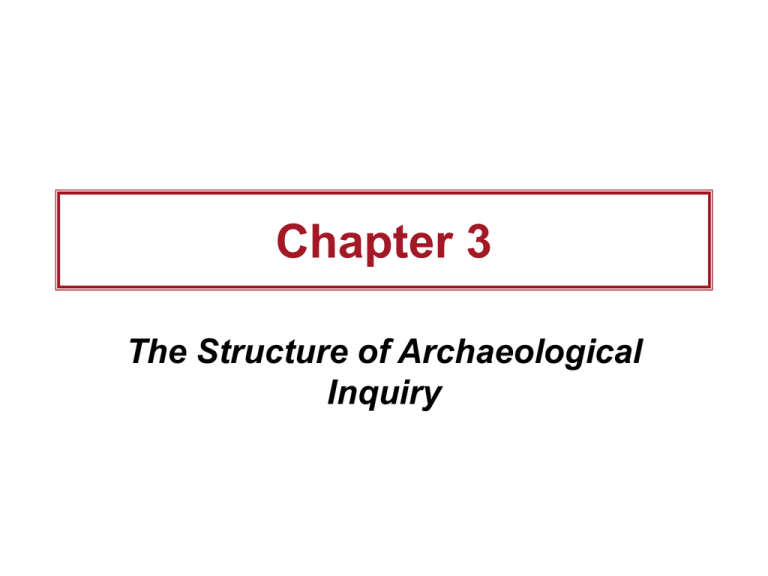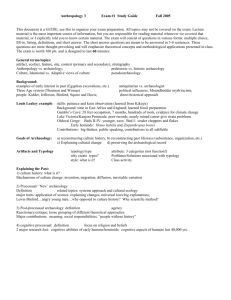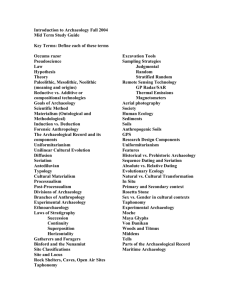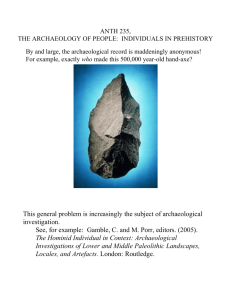Chapter 3
advertisement

Chapter 3 The Structure of Archaeological Inquiry Outline • • • • • • • Levels of Theory Paradigms Paradigms in Archaeology Is Postmodernism All That New? Archaeology Today The Structure of Archaeological Inquiry Conclusion: Processualist or Postprocessualist? Theory • An explanation for observed, empirical phenomena. • It is empirical and seeks to explain the relationships between variables; it is an answer to a “why” question. Paradigm • The overarching framework, often unstated, for understanding a research problem. • It is a researcher’s “culture.” Rockshelter • A common type of archaeological site, consisting of a rock overhang that is deep enough to provide shelter but not deep enough to be called a cave. – ecofact Plant or animal remains found in an archaeological site. Feature • The nonportable evidence of technology. • Examples: fire hearths, architectural elements, artifact clusters, garbage pits, soil stains. Gatecliff Shelter • A prehistoric rockshelter in Nevada where people camped over a 7000 year period. • Buried in Gatecliff Shelter were: – Artifacts: bone awls, baskets, grinding stones, woven sagebrush bark mats, shells and turquoise used as ornaments. – Ecofacts: bighorn sheep bones, charcoal, piñon nut hulls, and pollen. – Features: pits, hearths, rodent burrows Data at Gatecliff Shelter • No data was found at Gatecliff shelter. • Archaeologists do not excavate data, they excavate objects. • Data are observations made on those objects. Theories • low-level theories - observations and interpretations from hands-on field and lab work. • middle-level theory - hypothesis that links archaeological observations with human behavior or natural processes that produced them. • high-level theory - theory that seeks to answer large “why” questions. Experimental Archaeology • Experiments to determine the archaeological correlates of ancient behavior. – ethnoarchaeology - The study of contemporary peoples to determine how human behavior is translated into the archaeological record. – taphonomy - The study of how organisms become part of the fossil record. Paradigms in Archaeology • Processual paradigm – Explains social, economic, and cultural change as the result of adaptation to material conditions. • Postprocessual paradigm – Focuses on humanistic approaches and rejects scientific objectivity; more concerned with interpreting the past than testing hypotheses. Cultural Materialism • Views environmental, technological, and economic factors as the most powerful and pervasive determinants of human behavior. • By exclusively embracing a scientific framework to examine the effects of material factors on human societies, cultural materialists reject humanist, ideational approaches and advocate the adaptive view of culture. Cultural Materialists • Use three fundamental concepts in their approach: – Infrastructure – Structure – Superstructure Infrastructure • Food, shelter, reproduction, and health • Mediates a culture’s interactions with the natural and social environment through: – Mode of production - technology, practices, and social relations used in basic subsistence production – Mode of reproduction - technology, practices, and social relations used to expand, limit, and maintain population. Structure • Made up of interpersonal relationships that emerge as behavior. • Domestic economy - organization of reproduction and production, exchange, and consumption within domestic settings. • Political economy - organization of reproduction, production, exchange, and consumption within and between bands, villages, chiefdoms, states, and empires. Superstructure • Refers to a society’s values, aesthetics, rules, beliefs, religions, and symbols, which can be behaviorally manifested as art,music, dance, literature, advertising, religious rituals, sports, games, hobbies, and even science. Principle of Infrastructural Determinism 1. Human society strives to meet the needs most important to the survival and well-being of human individuals (sex, sleep, nutrition, and shelter). 2. The infrastructure determines the rest of the sociocultural system. How the Cultural Materialist Views Causality Contrasts: Processual and Postprocessual Archaeology Processual Archaeology Emphasizes evolutionary generalizations, and regularities, downplays the importance of the individual. Views culture from a systemic perspective and defines culture as adaptation. Postprocessual Archaeology Rejects the search for universal laws and regularities. Rejects the systemic view of culture. Contrasts: Processual and Postprocessual Archaeology Processual Archaeology Postprocessual Archaeology Explanation is explicitly scientific and objective. Rejects scientific methods and objectivity. Argues that all archaeology Attempts to remain is unavoidably political. ethically neutral; claims to be explicitly nonpolitical. Enlightenment • A shift in Western philosophy that advocated absolute truth, science, rational planning of ideal social orders, and standardization of knowledge. – Science and technology would free people from the oppression myth, religion, and superstition. – Control of nature through technology would permit the development of moral and spiritual virtues. Postmodernism • Argues that there really is no truth and no coherence except that all understanding and meaning is “historically situated.” • Our understanding of the world is not really truth, but rather only a product of the time in which we live. A Model of Archaeological Inquiry Quick Quiz 1. A _____ is the overarching framework for understanding a research problem. Answer: paradigm • A paradigm is the overarching framework for understanding a research problem. 2. Low-level theories seek to answer large “why” questions. A. True B. False Answer: B. False • Low-level theories are observations and interpretations from hands-on field and lab work, high-level theories seek to answer large “why” questions. 3. This paradigm explains social, economic, and cultural change as the result of adaptation to material conditions. A. Processual paradigm B. Postprocessual paradigm C. Cultural materialism D. Postmodernism E. None of the above. Answer: A • The processual paradigm explains social, economic, and cultural change as the result of adaptation to material conditions. 4. Cultural materialism A. Argues that there is no truth and that all meaning is “historically situated.” B. Views environmental, technological, and economic factors as the most powerful determinants of human behavior. C. Believes science and technology will free people from oppression. D. None of the above. Answer: B • Cultural materialism views environmental, technological, and economic factors as the most powerful determinants of human behavior.





